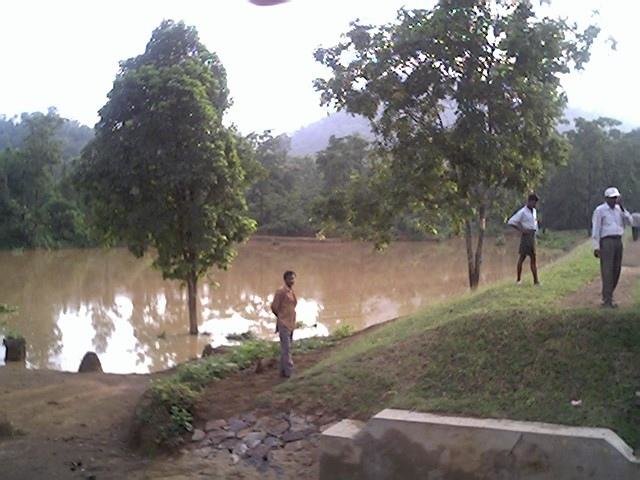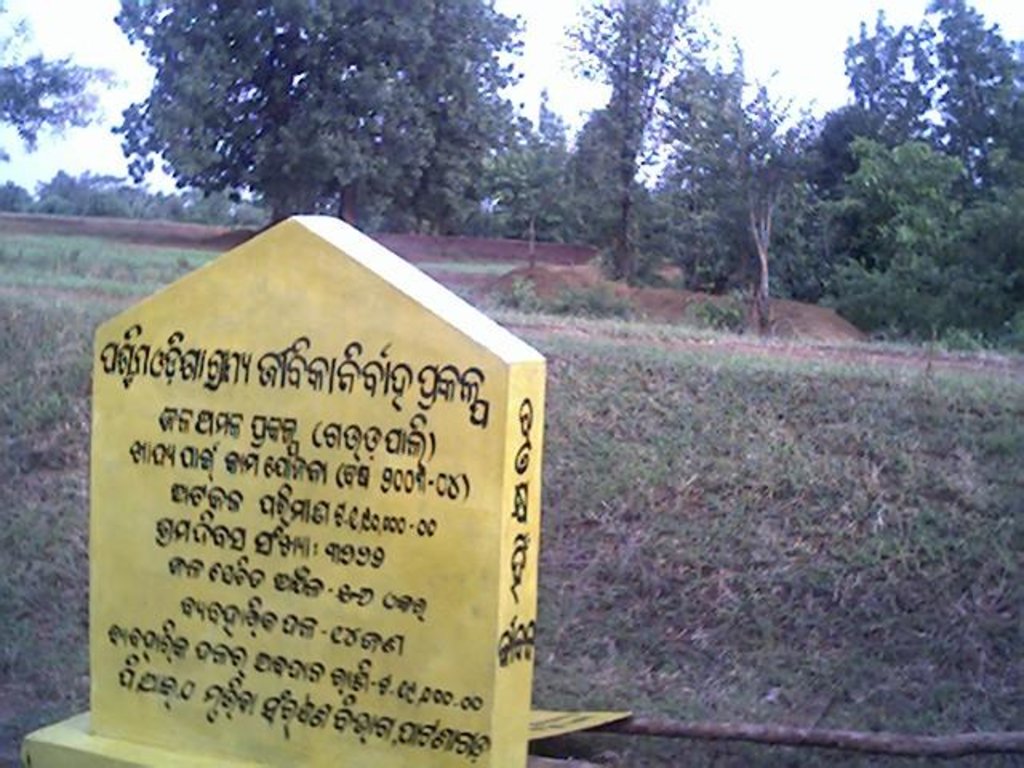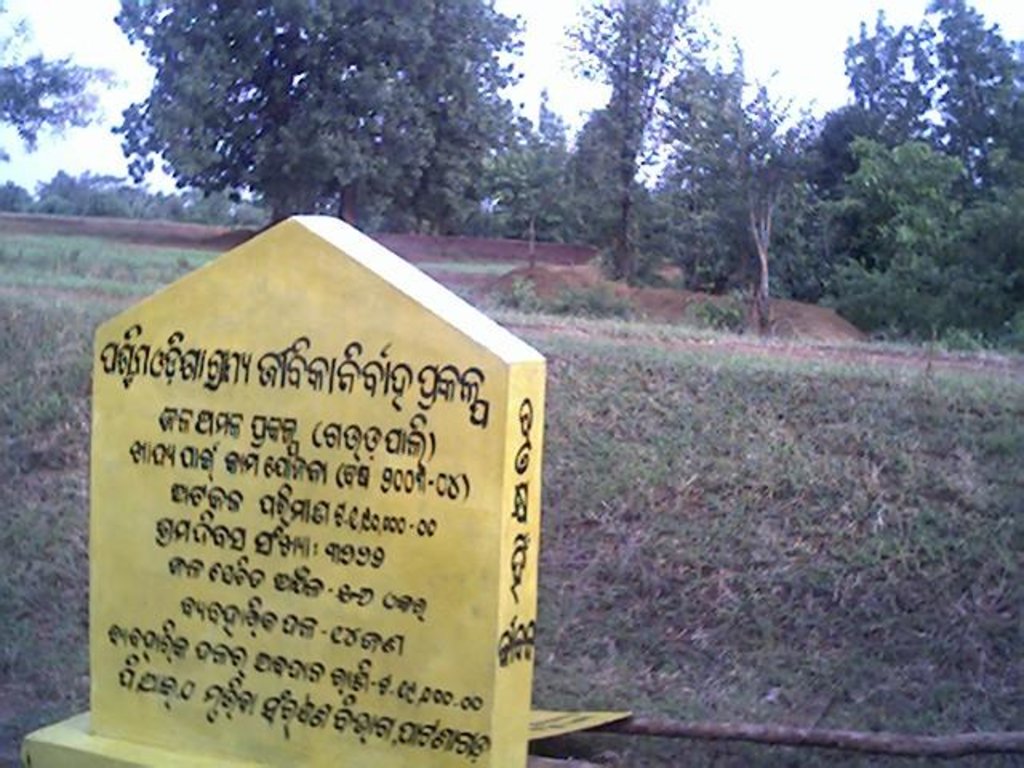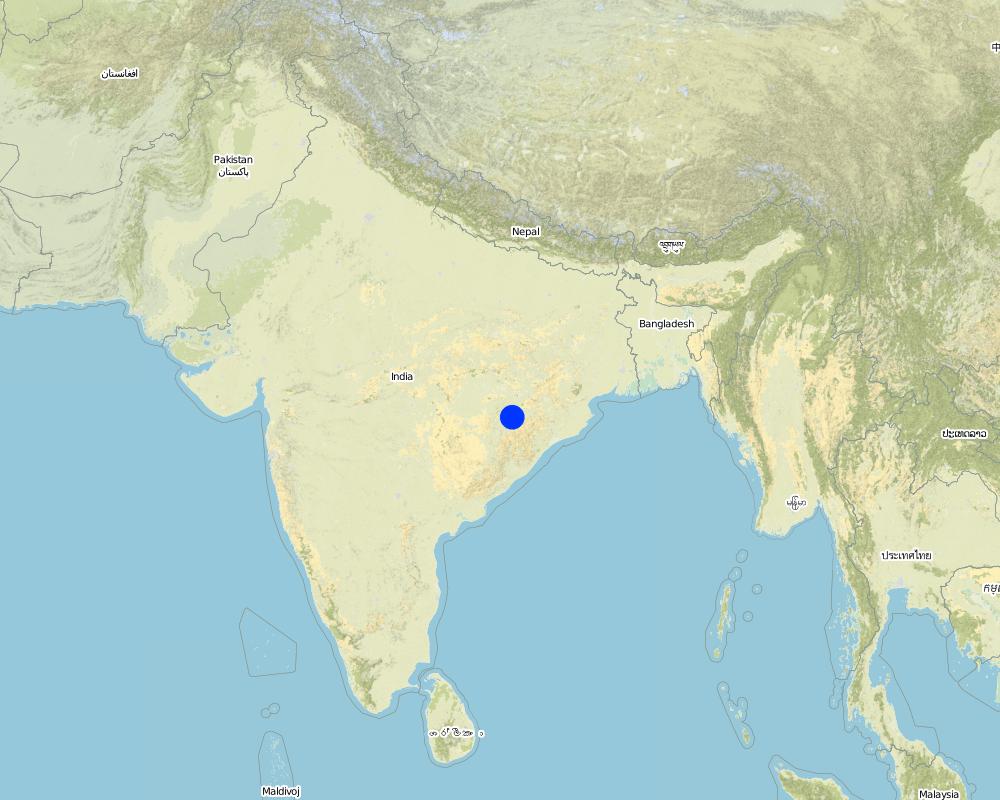Community based sustainable livelihoods [印度]
- 创建:
- 更新:
- 编制者: Unknown User
- 编辑者: –
- 审查者: Fabian Ottiger
approaches_2371 - 印度
查看章节
全部展开 全部收起1. 一般信息
1.2 参与方法评估和文件编制的资源人员和机构的联系方式
关键资源人员
SLM专业人员:
Mohanty Rajib Kumar
印度
1.3 关于使用通过WOCAT记录的数据的条件
编制者和关键资源人员接受有关使用通过WOCAT记录数据的条件。:
是
1.4 SLM技术问卷的参考

Dug-out sunken pond cum countour bund [印度]
It can be defined as combination of structural & vegetative measures where contour bunds are constructed from the excavated sandy loam soil of cultivated wastelands in semi-arid climatic(?) zone with moderate slope in medium soil depth conditions in order to link with self-subsistance & market oriented production systems from private …
- 编制者: Unknown User
2. SLM方法的描述
2.1 该方法的简要说明
Sustainable livelihoods enhanced through people's organisations by linking with other resource organisations prticularly for resource poor.
2.2 该方法的详细说明
该方法的详细说明:
Aims / objectives: The name of the project is western orissa rural livelihoods project, supergoal-reduction of poverty in rainfed areas of India, goal- More effective approaches to sustainable rural livelihoods adopted by government agencies & other stakeholders in KBK districts & elsewhere. The overall purpose is sustainable livelihoods, particularly fo the poorest, promoted in 4 districts in replicable ways by 2010 & to reduce poverty by promoting livelihoods initiatives particularly resource poor. Unlike DFID(I)'s earlier rural development projects, WORLP will work within government & follow GOI's watershed guidelines, but extra resources for ' watershed plus' activities: capacity building, minor irrigation, drinking water & livelihood initiatives for the poorest. WORLP is a part of wider effort to help Ministry of Rural Development (MoRD) improve the effectiveness of watershed work nationally;'watershed plus' approach developed in WORLP will be tested for wider replication.
Methods: The project will have basically four types of impact: production impact, employment impact, Poverty alleviation impact & capacity building impact.The project would directly reavh a population of 725,000 people, 80% of whom would be people below poverty line-landless, marginal & small farmers. The Director of the Watershed Mission will answer to an empowered committee chaired by the Chief Secretary; district level will be strenghthened by the appointment of a Project Director-Watershed projects & staff to work alongside the District Rural Development Agencies, funds will be tranferred from the PD-DRDA to the PD-WSP; GoO has appointed full time watershed development teams at block level to support implementation of the KBK plan; WORLP may use these teams, but can also use other government agencies(including Forestry Department in areas with forest land) or NGOs as PIAs. DFID will finance a Project Support Unit at Bhubaneswar, Capacity Building Teams in districts & Livelihood Support Team at block level. The project will fall under state leve Watershed Mission, created to oversee implementation of all MoRDIts main focus is to work with existing strengths & build upon them. In this area 60 to 70% of th population live below official poverty line. Erratic rainfall, limited irrigation, poor capacity of government agencies & restricted opportunities for non-land based activities are major factors. But the key to poverty seems to be the structure of social relations: caste, untouchability, skewed land distribution, land alienation, dependence on money lenders, encroachment on common property resources, gender issues, all of which prevent access by pooe groups to natural resources.
2.3 该方法的照片
2.5 采用该方法的国家/地区/地点
国家:
印度
区域/州/省:
ORISSA
Map
×2.6 该方法的开始和终止日期
注明开始年份:
2001
终止年份(若不再采用该方法):
2010
2.7 方法的类型
- 基于项目/方案
2.8 该方法的主要目的/目标
The Approach focused mainly on SLM with other activities (organising the people in general, & poor (defined by the criteria of villagers), analysis of of problems, constraints, opportunities, threat concerning five capitals like physical, social, natural, finacial & human &)
The objectives of the project approach are mainly three components. Promoting livelihoods improvements, capacity building of primary & secondary stakeholders & encouraging an enabling environment.
The SLM Approach addressed the following problems: Coping strategy against Drought, distressed migration, income in the lean period. Other problems are like employment opportunities, farm & non-farm activities for lan users & landless.
2.9 推动或妨碍实施本办法所适用的技术的条件
社会/文化/宗教规范和价值观
- 阻碍
Unity & transparency
Treatment through the SLM Approach: Awareness, training, exposure visits,Regular rapport building etc.
财务资源和服务的可用性/可得性
- 阻碍
Capital for initiatiation of any activities.
Treatment through the SLM Approach: Project fund
机构设置
- 阻碍
People's organisations not strenghthened
Treatment through the SLM Approach: Formation of institution like Self help group, User group, Watershed committee, Community link workers.
法律框架(土地使用权、土地和水使用权)
- 阻碍
Legal provisions like access to Common property resource, rights on assets created etc.
Treatment through the SLM Approach: capacity building on legal provisions.
The existing land ownership, land use rights / water rights moderately hindered the approach implementation operational holdings are highly skewed, appr. 30% of households are landless, & 40-50% are small & marginal farmer, land allienation is wide spread because of indebtedness. Motgaging the land is the outcome due to heavy dependence on private money landers charging unserious rate of interest. Skewed control of land & water. Officially 10% of people own 35% of project area land, inreality appr. 60%
了解SLM,获得技术支持
- 阻碍
Estimates, lay-out & planning
Treatment through the SLM Approach: Regular training to volunteers to create a bare-foot professionals in the village.
其他
- 阻碍
Community mobilisation
Treatment through the SLM Approach: Common meeting, focus group discussion, adressing household problems.
3. 相关利益相关者的参与和角色
3.1 该方法涉及的利益相关者及其职责
- 当地土地使用者/当地社区
Wok equally divided between men and women (User's group or Area group mainly men, as most of the land is on the name of men. Self help groups are mainly from women. Although women participated in decision making process & also in the activities, but still men take the important decisions particularly for SWC measures. Perhaps mostly the lands are owned by men. Therfore, participation of men in comparison to women for SWC measures is more. In this connection, villagers opine that women participated benevolently for the first time for planting of seedlings. Some landless goup receives uncultivated wate land in meagre amount 0.5 ha whose land is part of the patch. Nextly representative from th resource-poor & very poor category as per the defined criteria of the villagers are also member of the watershed committee. As the watershed committee mainly responsible for any work because the money flows directly to the watershed committee account.
- 国家政府(规划者、决策者)
- 国际组织
A project implemnting agency is appointed at the block level
如果涉及多个利益相关者,请注明领导机构:
A team of international & national specialist did the study of the four poverty stricken districts of the state. Than they drafted the Project meomrandum which is a broader framework of guidelines stating the robust processes. But it is so flexible in nature that it has every scope for modification as required or desired by the landusers.
3.2 当地土地使用者/当地社区参与该方法的不同阶段
| 当地土地使用者/当地社区的参与 | 指定参与人员并描述活动 | |
|---|---|---|
| 启动/动机 | 被动 | public meetings; People started participating because root cause of every problem becomes clear to the community. Interaction with all villagers again & again through public contacts |
| 计划 | 被动 | rapid/participatory rural appraisal; Planning at time of drafting of micro-plan the land users went for transact of the area along with SWC specialist to sense the problem & alternative solutions. |
| 实施 | 外部支持 | Mainly: responsibility for minor steps; partly: casual labour; The implementation of the SWC was done by the User's group with supervision of Watershed committee. The Watershed committee provide cheque to the User's group. |
| 监测/评估 | 无 | Mainly: measurements/observations; partly: reporting; The monitoring is done at time of measurements/observation by the secretary & watershed committee. The rgular reporting was done by the watershed development team. |
| Research | 自我动员 | on-farm; On-farm demos of the agriculture, integrated nutrient management, intercropping & line sowing etc. |
3.4 有关SLM技术选择的决策
具体说明谁有权决定选择要实施的技术:
- 主要是土地使用者,由SLM专家提供支持
解释:
Firstly the Project implementing agency & team initiate the discussion in different ways, like training, exposure visits, focused group discussion.The first phase is called rapport building phase for one year, when the livelihood focused micro-plan is prepared. The micro-plan can be modified time to time as per the need & concern of the community.
Decisions on the method of implementing the SLM Technology were made by mainly by land users supported by SLM specialists. In this approach in general & SWC measures in particular, firstly the land user's group raise proposal before the committee. The criteria behind the selection is poor land, poor people, contribution & ridge to valley approach. Than the land users agree to
4. 技术支持、能力建设和知识管理
4.1 能力建设/培训
是否为土地使用者/其他利益相关者提供培训?:
是
明确受训人员:
- 土地使用者
- SWC specialists (1), extensionists/trainers (2), planners (3)
培训形式:
- 在职
- 农民对农民
- 示范区域
- 公开会议
- 课程
涵盖的主题:
Reconnainance survey through maps. Transact of the area, Identification of root cause of the problem & alternative solution & demonstration of different items so that the land users get a basket of choices. Another objective of the project to develop volunteers who will get some remuneration & help the land users for future maintainance, estimate, lay-out etc.
4.2 咨询服务
土地使用者有权使用咨询服务吗?:
是
指明是否提供了咨询服务:
- 在土地使用者的土地上
说明/注释:
Name of method used for advisory service: Community based sustainable livelihoods.; Key elements: Amalgamation of social & natural resource., Agreement of User's grop, benefit sharing, conflict resolution, prioritisation, etc., Farmer to farmer extension, replication through 'learn by doing & teach by showing methods'; 1) Advisory service was carried out through: government's existing extension system, projects own extension structure and agents; Extension staff: mainly government employees 3) Target groups for extension: land users; Activities: Participatory resource mapping through T
Advisory service is inadequate to ensure the continuation of land conservation activities; It is because it is really to early to conclude about extention. It requires high degree of common sense & commitment. Although extension service is in place but it needs coordination & management which will be hopefully developed by the project within next 3-4 years.
4.3 机构强化(组织发展)
是否通过这种方法建立或加强了机构?:
- 是,非常
具体说明机构的强化或建立程度:
- 本地
具体说明支持类型:
- 财务
- 能力建设/培训
- 设备
4.4 监测和评估
监测和评估是该方法的一部分吗?:
是
注释:
bio-physical aspects were regular monitored through observations
technical aspects were regular monitored through observation
socio-cultural aspects were ad hoc monitored through observations
economic / production aspects were ad hoc monitored through observations
There were many changes in the Approach as a result of monitoring and evaluation: By timely monitoring & evaluation, the stages of the linked institutions are determined & capacity building was determined time to time. Fo example a training to SWC/NRM volunteers, supervision was done after regular interval. Than again after a time period the refresher training was devised as per the receptance of the concerned volunteers.
4.5 研究
研究是该方法的一部分吗?
是
明确话题:
- 社会学
- 经济/市场营销
- 技术
提供进一步的细节,并指出是谁做的研究:
Participatory technology development with proper admixture of social & natural resouce is one of the objective of the project. As the components of technology, social dynamics & economics are interwoven with each other, therefore, research through consultants of national & international repute is a regular part of the project process.
Research was carried out on-farm
5. 融资和外部物质支持
5.1 该方法中SLM组成部分的年度预算
如果不知道准确的年度预算,请给出一个范围:
- < 2,000
注释(例如主要的资助来源/主要捐助者):
Approach costs were met by the following donors: international (DFID): 100.0%
5.2 为土地使用者提供财政/物质支援
土地使用者是否获得实施该技术的财政/物质支持?:
是
5.3 对特定投入的补贴(包括劳动力)
- 设备
| 具体说明哪些投入得到了补贴 | 程度如何 | 对补贴做出具体说明 |
|---|---|---|
| 工具 | 部分融资 | |
- 农业
| 具体说明哪些投入得到了补贴 | 程度如何 | 对补贴做出具体说明 |
|---|---|---|
| Seedlings | 充分融资 | |
- 基建
| 具体说明哪些投入得到了补贴 | 程度如何 | 对补贴做出具体说明 |
|---|---|---|
| Community infrastructure | 充分融资 | |
注释:
The unit of the project is a watershed & the project cost is rs. 9,500 per hac, out of which around rs. 3,600/ is for direct SWC measures & rest is for enhancement of livelihood assets & linking to self-sustainable institutions.
5.4 信用
是否根据SLM活动的方法给予信用值?:
是
对条件(利率、回报等)进行具体说明:
Interest rate charged: 8.0%; repayment conditions: From the project side it one time grant to the watershed committee. But the watershed committee gives loan to groups or individual as per their own norms & condition. As the the project is trying to have a revolving fund in the watershed level for future mainatinance & requirement..
Interest was lower than market rate.
请具体指明信贷接收人:
The person who will avail loan must be in aself help group & must pass through the grading process w
6. 影响分析和结论性陈述
6.1 方法的影响
该方法是否帮助土地使用者实施和维护SLM技术?:
- 否
- 是,很少
- 是,中等
- 是,支持力度很大
The crop-diversification like change from the minor millets to cash crop & paddy. The land where only one crop season, but now they are taking up two crops, like kharif & pre-Rabi crops etc.
该方法是否改善了阻碍SLM技术实施的土地使用权/用户权问题?:
- 否
- 是,很少
- 是,中等
- 是,支持力度很大
Villagers are classified under 4 categories, well-off, manageable, poor & very poor as per the criteria developed by villagers. For the project norms except well-off all are target group. At that time the contribution from a resource rich farmer was collected cash. The resource poor farmers were given a period of time & collected out of contribution of labour.
Did other land users / projects adopt the Approach?
- 否
- 是,很少
- 是,中等
- 是,支持力度很大
It is very difficult to quntify in this stage. But the reprentatives of nearly 15 Project areas visited under exposure visits. The Project implementing agencies of other districts states also visted & learnt the technology & outcome of the technology in form of production from the land, crop-diversification.
6.3 方法活动的可持续性
土地使用者能否维持通过该方法实施的措施(无外部支持的情况下)?:
- 不确定
若否或不确定,请具体说明并予以注释:
It is because although it was hoped but one project cycle of 5 years is not over to give concluding remarks.
6.4 该方法的长处/优点
| 编制者或其他关键资源人员认为的长处/优势/机会 |
|---|
| Equity in investments, with a particular focus on developing SWC on the land of small & marginal farmers, often in the upper catchment. (How to sustain/ enhance this strength: The review & montoring as per the micro-plan developed by the villagers of the watershed.) |
| Generating employment for those most in need in the early phases to provide immediate relief from indebtedness & impoverishment & need to migrate. |
| A group approach built around the establishment of revolving fundsto provide alternative credit sources. Site specific approaches ranging from rainfed SWC measures to increasing |
7. 参考和链接
7.1 方法/信息来源
- 实地考察、实地调查
- 与土地使用者的访谈
链接和模块
全部展开 全部收起链接

Dug-out sunken pond cum countour bund [印度]
It can be defined as combination of structural & vegetative measures where contour bunds are constructed from the excavated sandy loam soil of cultivated wastelands in semi-arid climatic(?) zone with moderate slope in medium soil depth conditions in order to link with self-subsistance & market oriented production systems from private …
- 编制者: Unknown User
模块
无模块





